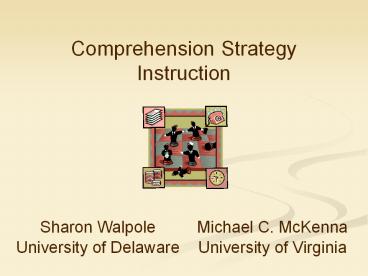Michael C. McKenna - PowerPoint PPT Presentation
1 / 21
Title:
Michael C. McKenna
Description:
How did your teachers respond to the Duffy study group? ... Duffy's Explanation Template. What is the lesson objective? ... Duffy, G. G. (2002). The case for ... – PowerPoint PPT presentation
Number of Views:107
Avg rating:3.0/5.0
Title: Michael C. McKenna
1
Comprehension Strategy Instruction
Michael C. McKenna University of Virginia
Sharon Walpole University of Delaware
2
Todays Goals
- Review history of comprehension research
- Situate comprehension within our GARF framework
- Read about scaffolding during reading
- Consider applications to information text
3
Back in School . . .
- Conduct a comprehension strategy read-aloud from
a text matched to one of the GPS standards for
science and to the strategy instruction included
in your core reading program - Create materials to facilitate comprehension
strategy instruction for your teachers
4
What should we teach in the primary grades?
- Text structure elements
- Visualizing
- Summarizing
- Predicting based on prior knowledge
- Questioning
- Clarifying
AND Fluent Word Recognition
Duke Pearson, 2002
5
Some History
- 1970s
- Focus on teaching study skills through a series
of procedures - Do you remember SQ3R?
- Research interest in very specific aspects of
thinking and memory - Mental images
- Summaries
- Story grammars
- Identification of skilled reader strategies
Pressley, 2002
6
Schema Theory
- Comprehension involves complicated
- processing of ideas!
- We need to activate prior knowledge in order to
really understand text - We need to connect text ideas to what we already
know - We need to build meaning during reading
- Knowledge is built from these connections.
Anderson Pearson, 1984
7
http//www.sil.org/lingualinks/literacy/ImplementA
LiteracyProgram/SchemaTheoryOfLearning.htm
8
1980s Multiple Strategies
Reciprocal Teaching
Procedures can help
Discussion can help
Described in Pressley, 2002
9
1980s Multiple Strategies
Direct Explanation
Focus on mental reasoning
Apply strategies to real text
Duffy, 2002
10
1990s Multiple Strategies
Transactional Strategies Instruction (SAIL)
Good reader strategies can help
Thinking aloud can help
Described in Pressley, 2002
11
Now Comprehension Acquisition
Interactive Read-Alouds
Spontaneous interaction is important
Information books are important
Smolkin Donovan, 2002
12
- How did your teachers respond to the Duffy
study group? - To what extent were ideas from this book used to
improve comprehension strategy instruction?
13
Duffys Explanation Template
- What is the lesson objective?
- What is the secret about comprehension being
targeted? - How will you introduce it?
- How will you model it?
- How will you scaffold student application?
- How will students apply the secret?
- How will you assess their success?
- How can you have them apply the secret in writing?
14
Some GARF Assumptions
- Reading comprehension strategies must be modeled
across the elementary grades, across texts and
text types, and across content areas - Read-alouds are important opportunities for
comprehension instruction and practice - Science and social studies standards can be
developed during read-alouds inside the GARF
block
15
How can I ask my teachers to do these read alouds
without abandoning the core?
The core provides many of the tools they need --
the comprehension strategies, the modeling talk,
graphic organizers to help -- and they can be
applied and practiced in additional contexts.
16
Coaches Corner
- Has anyone been successful in supporting teachers
to use these techniques? What are your secrets?
17
- Clark, K. F., Graves, M. F. (2004). Scaffolding
student comprehension of text. The Reading
Teacher, 58, 570-580.
Read this article. It focuses attention on
various definitions and applications of
scaffolding, central to expert comprehension
instruction. Think about whether your teachers
are actually scaffolding student understanding
and what you might do to help them.
18
Lets Plan . . .
19
How could you support teachers?
- Make a calendar to summarize the strategy
introduction from the core (so that they will
know what has already been introduced)? - Make some strategy-introduction cards that the
teachers could use as they become more familiar
with strategy instruction? (Weve brought some
samples to share.) - Start to share lesson plans?
20
Back in School . . .
Conduct a comprehension strategy read-aloud from
a text matched to one of the GPS standards for
science and to the strategy instruction included
in your core reading program. Create materials to
facilitate comprehension strategy instruction for
your teachers. Prepare a reflection to share with
the group at our next meeting.
21
References
- Duffy, G. G. (2002). The case for direct
explanation of strategies. In C.C. Block M.
Pressley (Eds.), Comprehension instruction
Research-based best practices (pp. 28-41). New
York Guilford Press. - Duke, N. K., Pearson, P. D. (2002).
Comprehension instruction in the primary grades.
In C.C. Block M. Pressley (Eds.), Comprehension
instruction Research-based best practices (pp.
247-258). New York Guilford Press. - Pressley, M. (2002). Reading instruction that
works The case for balanced teaching (2nd ed.).
New York Guilford Press. - Smolkin, L. B., Donovan, C. A. (2002). Oh
excellent, excellent question! Developmental
differences and comprehension acquisition. In
C.C. Block M. Pressley (Eds.), Comprehension
instruction Research-based best practices (pp.
140-157). New York Guilford Press.































